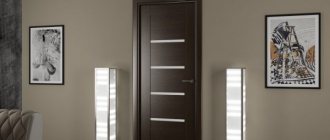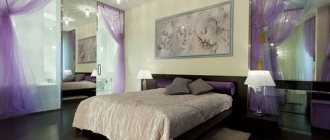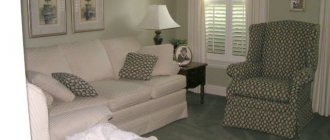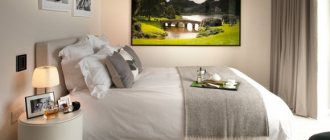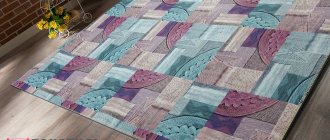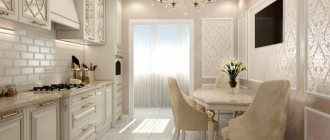It is not for nothing that walnut-colored furniture is one of the most popular segments in the production of interior items. Deep shades, expressive natural patterns, strength and pliability of the material attract both furniture craftsmen and manufacturers of finishing materials. A wide palette of shades - from light “honey” tones to very dark, deep mahogany, can transform any interior - from classic to ultra-modern.
Of course, the color of walnut varies depending on the type of wood and can be presented in various shades, colorful combinations, and various variations of the veins of the wood pattern. The following variations of this durable but easy-to-process material for the manufacture of furniture and finishing elements can be found on wide sale:
Not only furniture, but also doors, flooring, wall panels, tabletops, decorative elements and picture frames are made from walnut wood. Many homeowners, on their own or with the help of professionals, would like to bring the warmth of natural materials into the interior of their home. Let's try together to figure out with what room decoration, color palette, textiles and decor it is more effective and attractive to combine different variations of walnut wood.
Walnut color in the kitchen and dining room
If the design of the room is based on walnut color, then it is necessary to prioritize the use of shades and clearly distribute proportions. To simplify, the “walnut theme” in space can appear in two variations. The first type involves the use of a walnut dominant - it is one of the types of wood that becomes the basis of the furniture - a kitchen set, for example. Such a design of space will require excellent natural and artificial lighting - large windows and a multi-stage lighting system in this case will help preserve the warmth of the natural material. The second option for using walnut shades is the so-called “companion walnut”, which effectively complements the main decor of the space and often acts as an accent or softens the existing brightness of the design.
Not every kitchen space can harmoniously accommodate an entire furniture ensemble made of walnut wood. The beautiful natural pattern of walnut goes well with light shades and acts as a contrasting dark accent in this case. The use of a dark walnut shade for the lower tier of kitchen cabinets and the base of the island in combination with the light top of the furniture set allows not only to create a colorful and practical ensemble, but also to visually increase the height of the room.
The pronounced natural pattern of walnut does not require decoration. Therefore, most kitchen fronts made of this material are either presented in a completely smooth version, or are accompanied by the simplest and most laconic fittings, which cannot distract attention from the main element of the furniture ensemble. For the same reasons, it is better to choose monochromatic countertops for a kitchen set, excluding variations on the theme of stone (or its imitation) with an equally rich natural texture - veins and tints, changing shades and colors.
Another way to use walnut wood in the kitchen space is for flooring and countertops. In order for the natural grain of wood to be most advantageously presented, it is recommended to use wooden countertops in combination with light, monochromatic facades of kitchen cabinets. The combination of the countertop material with the floor covering will harmoniously complete the image of the cooking area.
For dark, deep walnut tones, a spacious and bright dining room is perfect. The rigor and clarity of the dining group will look especially advantageous against the light background of the flooring, snow-white walls and sunlight breaking through the panoramic windows.
Walnut is a fairly pliable material for making furniture. Durable, but at the same time flexible natural raw materials allow you to create original shapes - chairs with curved legs, tables and stands of elegant design, original backs for mini-chairs.
The walnut dining table itself looks luxurious, solid and a little vintage. Its massiveness is in pleasant proximity to natural naturalness. Such a practical element of the interior can become the focal point of modern design, gathering around it furniture and decorative items decorated in a completely different manner. And at the same time, the whole composition will look harmonious, original and at the same time functional.
Brown-honey walnut shades integrate perfectly into almost any interior style. Modern motifs in the design of a kitchen or dining room harmoniously embrace natural warmth, counterbalanced by stainless steel household appliances, glossy facades, glass surfaces and an abundance of built-in lighting.
The decoration of the area for breakfasts and other short meals can be an original group made of luxurious Milanese walnut. The curved legs of a small table, the elegant design of the tabletop, comfortable, but at the same time aesthetically attractive chairs - such an ensemble with colorful colors will look great in a warm and bright environment. Pieces of furniture installed near the window are bathed in sunlight, giving us the opportunity to see the unique natural pattern of natural material in all its glory.
Furniture colors
Before choosing a new set for your bedroom, living room or kitchen, you need to study the wide range of materials from which the interior items are made. For example, products made from veneered or painted MDF have many different colors and shades. Color solutions for upholstered or cabinet furniture made from natural solid wood are more limited and, as a rule, depend on the texture of the wood.
How to choose the color of furniture for a small apartment or a spacious country mansion? The choice of color is particularly influenced by the overall design, size, and purpose of the living space. To decorate a modern living room, decorators advise using deep, saturated colors; for a bedroom, lighter shades are more suitable; in the hallway, it is recommended to use the texture of valuable wood species.
It should be noted that the color scheme may vary slightly among different manufacturers, but despite this, the entire variety of shades can be divided into groups. Each category has the name of the type of wood it corresponds to. Below are the most popular colors of furniture, photos with names will help you not to make a mistake with your choice and choose the right color.
Dark
Deep dark shades of the facade are often used to create aristocratic classic interiors. Exquisite design allows you to create an atmosphere of luxury and splendor in the interior, introducing notes of conservatism and respectability.
Dark shades include:
- walnut - traditional dark brown shade;
- wenge - blue-black or chocolate color;
- mahogany - spectacular dark burgundy decor;
- Ebony – African ebony has a unique black tone.
To prevent the atmosphere from looking boring and dull, it is necessary to correctly select the shades of decorative coverings of the walls, floors and ceilings.
For furniture painted black, dark grey, chocolate or traditional brown, a neutral background is more suitable - this will create a calm, homely atmosphere. If interior elements with a mahogany texture are used to furnish a living space, it is recommended to choose wallpaper for the walls of a similar shade, but several tones lighter. A design with a dark color palette is ideal for spacious, well-lit living rooms, dining rooms, or hallways.
Light
Particularly popular are cabinet furniture items with light shades of the facade. Correctly selected colors can create the effect of maximum freedom and spaciousness in a small room. Light-colored natural solid wood is used to create interior doors and decorative wooden partitions. The snow-white surfaces of the facade fit harmoniously into any modern interior.
Decorated with gold or bronze floral patterns, the set will become a real decoration of the luxurious imperial style. Aged furniture in the Provence style is organically combined with blue and green wall coverings and is suitable for furnishing a country mansion or a small country house.
The most famous light shades include:
- Karelian birch - delicate yellowish tone with a pattern of knots;
- light ash - creamy background with an interesting smooth structure;
- pine - golden tone, characterized by richness;
- light beech - beige tone with a bright pinkish tint.
Walnut wood in the living room
Walnut wood of different species has a pronounced structure, its natural pattern is so attractive and unique that simple and laconic forms are often used in the production of furniture. Strict facades without decoration, often with hidden fittings, can become the highlight of the interior only thanks to the unusual texture of the material. As the most harmonious background for such a colorful natural pattern, it is better to choose plain, neutral shades, light colors.
Honey shades of walnut combine perfectly with natural shades - orange, light green, yellowish-ocher, mustard color, allowing you to create a truly comfortable, relaxing, pleasing to the eye atmosphere in which everyone will feel cozy.
A visual expansion of the living room space, including a visual increase in the height of the ceilings in the room, can be achieved by using dark, deep shades of walnut wood to create low pieces of furniture (such as chests of drawers and other small modular solutions), as well as flooring in combination with light finishes walls and a snow-white ceiling.
Walnut dominates the living room - a luxury that is only possible in truly spacious and bright rooms. If your living room has not only a large area, high ceilings, but also panoramic windows that fill the entire room with sunlight, then the use of wooden panels to decorate the walls and even the ceiling can become the highlight of the interior. But even in a spacious room, it is better not to use all surfaces for decoration with walnut wood - leave at least one, accent wall in this case, with a light finish.
If using walnut furniture in your living room seems too bold for you, then try using the beautiful natural pattern of this durable and colorful material as a flooring material. Of course, a floor board made of natural material is not only environmentally friendly, beautiful and safe for humans, but also quite expensive. There are many variations of laminate on the market in different shades of walnut wood. This type of floor design will add a touch of natural warmth and naturalness to any living room interior. A harmonious completion of the image of a family space will be a coffee table matched to the color of the floor covering, installed in the center of a relaxation area with upholstered furniture.
Another possibility of using walnut wood in the living room space is to design the space around the fireplace, built-in shelving or just open shelves, a frame for a mirror, paintings or photos above the fireplace. Symmetry, luxurious deep wood color and fire in the fireplace - all together will look harmonious, bringing balance and comfort to the decor of the room.
American walnut
American, Burmese, and European walnut are one tree growing in different places, from which the strength characteristics and texture differ slightly. For parquet, American walnut (Black Walnut) is usually used, which has a darker and uniformly colored wood. European walnut is variegated, so it is used extremely rarely for floors, but is popular in door decoration.
American walnut is the most stable exotic species for the Russian climate. The tree grows in a similar climate, so it easily tolerates temperature and humidity fluctuations. Walnut wood is elastic, so it is not prone to warping and splitting, like other exotic woods. American walnut is considered to be the darkest color that can be used in flooring. Anything darker is too impractical - all the dust and chips on the surface are visible.
The Sermon on the Mount states that plants are most easily and reliably identified by their fruits. Indeed, grapes do not ripen on thorn bushes, and figs are not collected from burdocks, even in modern conditions of advanced genetic engineering science. However, with nuts everything is much more complicated. They grow on coniferous and deciduous trees, palm trees and even underground!
When it comes to nuts, here, as in medicine or politics, you cannot find the most important expert and authority. We will not engage in such research either, but we will try to decide what it is. For people of the “old and new world,” nuts are primarily trees of the beech family, which bear tasty and healthy fruits. The most famous are walnut, Manchurian, black and pecan (kariya). In total, botanists count 22 types of “real” nuts, not counting subspecies.
And for Asians and Siberians, a nut is also the fruit of a prickly coniferous cedar, which is shaken out of its cones. Peanuts are also called nuts - they are generally from the pea-legume family and grow underground in pods. Coconut, famous for its copra and “milk” (those who have tried it will agree that it does not have the slightest taste similarity with cow or goat milk). And also - almond, cedar, hazelnut, beech, kola nut, nutmeg, pistachio, Maldivian, Brazilian - the list can be continued almost indefinitely.
In fact, recognizing different breeds is not easy - but the technology is there. Let's try to understand the so-called nuts and the plants that produce them. Let’s immediately discard the taste characteristics - after all, English “porridge” is morning oatmeal with a “nutty” (as the residents of Albion say) taste, no matter how Barrymore campaigned for it, it is clearly not of nut origin. Nuts grow only on trees, and everything else is a surrogate, fake or “homonym” - depending on the situation.
“Real” nuts are, after all, the familiar “walnuts” and other families of nuts, which in their purified form are similar to the human “mind”. Or the brain. And they value it primarily for its edible fruits. A true nut is a tree (!) of the nut family, which has significant dimensions - up to fifty meters in height and the diameter of which can exceed two meters, producing not only useful fruits, but also beautiful commercial wood. It is this wood that we will talk about, and we will outline the culinary and medicinal properties of real nuts at the end. The nut grows rapidly for the first fifty years, and in the next 150-200 years its growth slows down, and the trunk thickens mainly.
The wood of “real” walnut is quite hard - on the Brinell scale it reaches 5 units, the density of the wood ranges from 5.5 to 6.5 g/cm³. grows in warm countries of the northern hemisphere on all continents. European species have quite rich color variations, from gray-brown to slightly purple. American varieties (those grown in the USA and Canada, Juglans nigra) have darker wood and are slightly softer than European varieties. The structure and color of the nut greatly depend on the soil, climate and other conditions, but in any case it is always exceptionally beautiful. Since the color of the core part is uneven, the surfaces are obtained with an interesting and complex pattern and a peculiar play of light, appreciated by connoisseurs. Tough and durable, walnut wood is resistant to moisture, easily processed with any tools, polished, painted, stained, glued and connected with nails and screws. When dried, it warps a lot, but the dried one holds its shape well.
Walnut wood has long been valued as a high-quality material, which has become especially fashionable in recent years in the form of various types of floor coverings. Parquet and solid boards, piece parquet made of walnut will decorate most modern interiors. The popularity and value of this wood is confirmed by the well-known expression - “cut like a nut.” Nowadays it has acquired a negative connotation, but before it had a completely different meaning. And it meant that everything was done thoroughly, with high quality - this is how the old masters - cabinetmakers and professional carpenters - expressed themselves laudably.
Despite the value of walnut wood, it is essentially a “by-product” of the production of nut fruits, so no particularly large-scale harvesting is carried out - who would “cut the chickens that lay the golden eggs.” But when harvesting they are taken very seriously - they are often dug up by the roots. It is in the lower, basal sections of the trunk, tuberously thickened, that the most valuable wood is located. From these fragments they make the best veneer of curly texture with the richest patterns. Walnut burls, growths on trunks, also have these properties. At the beginning of the last century, there was a whole industry in the Caucasus for their extraction, but the predatory attitude most often led to the death of the mighty tree. After all, the size of the burl sometimes reached more than two meters in length and their weight exceeded half a ton! The annual export of walnut burls before the First World War exceeded one and a half thousand tons and the profit was a quarter of a million rubles (royal, full gold, not wooden, although they received them for wood).
Walnut is also used for exclusive gun stocks and butts, in the design of house interiors (except for floors, it is used for wall panels), furniture finishing, and even the insides of cars. But the best furniture and some parts of concert pianos are still made from solid wood, and not covered with veneer. Helicopter propellers are also made from walnut.
American walnut—that which grows in North America—has a slightly darker wood, to a chocolate color. To enhance color saturation, it is usually steamed. The wood is predominantly straight-grained. A little softer than European. American black walnut (Juglans nigra) looks especially advantageous under varnish - this is how the rich range of shades of its heartwood is revealed. Wood of similar quality comes from Myanmar - it is called Burmese walnut.
Walnut cultivation is a very profitable and profitable business. The tree is unpretentious, does not require special care, and is practically not affected by pests. Experts have calculated that growing a hundredweight of nuts is much cheaper than the same weight of grains or grapes, not to mention fruits. A planted tree begins to bear fruit after 7-8 years, and is capable of giving it to people for another 200, or even 300, years in ever-increasing quantities.
There’s probably no need to tell you what a walnut looks like - everyone has probably seen them and even tried them. Nut kernels contain oil - up to ¾ of the mass, as well as proteins, vitamins, and amino acids. They can serve as a complete replacement for meat - vegetarians use this. Walnut oil is valuable in composition and superior to the famous olive oil. However, it will not be possible to immediately press oil from the nuts - after harvesting, they must rest and ripen for a month or a month and a half, during which time the biochemical processes are completed. And it doesn’t last long, just like husked and shelled nut kernels - the oils oxidize and burn out.
The leader in nut production is China - it exports more than a million tons of them per year.
Since the kernel of the nut is similar in appearance to the human brain, in many countries in ancient times amazing properties were attributed to it. Plato, in his dialogues, argued that nuts can think and even hide from pickers. The ancient Babylonians, as Herodotus noted, forbade the common people from consuming them - it was believed that those who ate them could suddenly become wiser. Even in the last century, the famous geographer and traveler of Sweden, Sven Anders Hedin, believed that when green nuts are picked, they scream and cry. The latter, however, is not so far from the truth - modern research confirms that plants really respond to such influences.
Green pericarps are also a very useful thing; they contain a lot of α- and β-hydrojuglones, ascorbic acid and tannins. They make an excellent and very stable environmentally friendly brown dye.
Walnut leaves emit aromatic substances that repel insects. At the same time, they can cause trouble for some people - staying near the nut for a long time can cause a headache. They also act on cold-blooded animals - in the Caucasus, they “stupefy” (poison, but not to death) trout with nut leaves.
Bedroom with walnut-colored furniture
In a bedroom, like no other, walnut wood looks especially organic. Whether walnut dominates the interior or acts as a local inclusion, its presence in the design of a bedroom always brings notes of warmth and comfort, calm and relaxation, which we so need after a hard day in preparation for bed.
If you decide to use dark walnut to make not only the main piece of furniture in your bedroom - the bed, but also the rest of the furniture in the room, for example, a wardrobe, chest of drawers, dressing table or bedside tables, then you must understand that only spacious and bright room. If your bedroom has high ceilings and large windows, then dark, colorful shades of furniture against the background of light finishes (and even flooring) will look luxurious, advantageous, and unique.
Dark chocolate shades of walnut wood look very expressive and contrasting. But there should not be too many such elements in the bedroom interior. If you choose a similar color for bedside tables, a dressing table, or decorate a work area within a bedroom in this way, then you need to place this furniture on a light background. In this case, the use of a pastel palette and even snow-white color schemes for finishing almost all surfaces of the bedroom will be more justified than ever.
An original way to decorate a bedroom would be to use wooden wall panels to cover the surface behind the head of the bed. In the bedroom we want warmth and coziness, a comfortable environment that would contribute to a favorable preparation for sleep and a joyful awakening every day. It is precisely this attitude that can give a modern interior the naturalness of a natural finishing material. An accent wall decorated with walnut panels is impressive in itself, and together with wall decor it will look like a real focal point and semantic center of a room for sleeping and relaxing.
Even in a bedroom for a newborn, child or teenager, the use of walnut-colored furniture can be difficult to justify, but create a very special image of the room. Cribs and cradles for babies, bunk structures for two children and full-fledged sleeping places for teenagers can be supplemented with small chests of drawers, cabinets, bookcases or storage system modules in a different modification.
Bathroom – variations on the theme of walnut shades
Bathroom design is very rarely limited to only a standard set of plumbing fixtures, especially if we are not talking about modest-sized rooms in small apartments. In apartments with an improved layout or private households, it is difficult and simply inconvenient to do without furniture in the bathroom. Of course, increased demands are placed on the furnishing of utilitarian premises:
- it must be designed for active exposure to a humid environment;
- furniture must be chosen that is practical in order to provide the required level of storage capacity even in a small room;
- the surface of wooden furniture should be easy to clean in order to protect people from the appearance and proliferation of fungus, which can not only spoil the appearance of the furniture, but also cause harm to household members;
- and of course, the bathroom furniture should be attractive, you and your family members will like it.
If we don’t talk about the external beauty of walnut wood, everyone can be convinced of this. It is necessary to protect the material from moisture using special moisture-repellent compounds. Unfortunately, the naturalness of the material will have to be sacrificed to protect the products - the films, sprays and resins with which bathroom furniture are impregnated do not change the natural pattern or shade of the wood.
A bathroom in chocolate and honey tones is a haven of relaxation and tranquility. Pleasing natural shades will calm and relieve stress, clearing your thoughts while you cleanse your body. Different shades of brown, not only in furniture, but also in room decoration, can create a completely unique atmosphere.
In combination with brown-honey walnut shades in the design of storage systems and countertops in the sink area with brickwork, designed in the same color manner, it was possible to create a harmonious, but at the same time non-trivial image of a utilitarian room.
Walnut furniture in the office
If you want to interpret traditional English style in your modern office interior, then you can safely combine walnut wood with blue, emerald shades, use Marsala color, bottle green paints. The warm color temperature of furniture solutions will balance the cool palette of finishes and lead to the creation of a harmonious, but at the same time original workplace design.
If you decide to use walnut wood not only to decorate the furniture in your office, but also the flooring, doors and other interior items, then you need to take care of the lighting system at several levels. In such a space, you can’t get by with just one central chandelier. It will be better if the light can be reflected from light finishing surfaces, glass and mirror planes (cabinet doors, countertops, wall decor elements), multiplying and visually expanding the space. And it is better to base this concept not on a dark nut, but on honey or even sandy-golden shades of natural material.
Walnut furniture
An excellent idea for a classic interior would be Italian walnut color. It is used to paint furniture, floor coverings, wallpaper, and interior doors. The shade is magnificent; fans of deep and rich colors will appreciate it.
Dark colors
Dark walnut furniture goes well with most interior styles, both classic and modern. Honey-brown flowing lines with a rich pattern contrast nicely with white or coffee-colored walls, window light and decorative elements. This symbiosis of dynamics and tranquility in the kitchen is especially surprising, and in the bathroom it will not look alien.
Dark solid walnut changes the visual perception of the room, expands the space, becomes the starting point, the center of attraction, the dominant element of space organization. If you place a low table and chairs of this color, ceilings, especially white ones, will appear higher.
If such furniture is installed in a room or kitchen, care should be taken to ensure proper lighting that does not allow glare and shadows. The light must fall evenly on the surface, and this requires some distance.
Italian walnut color
Italian walnut is the most popular shade used for furniture production. It is more popular in our country than in the West.
This color has many characteristics, it:
- thick;
- saturated;
- soft;
- juicy;
- full of colors;
- rich.
The texture of the wood is extremely luxurious. It is characterized by clear lines and smooth transitions. This gives the interior sophistication, special charm, and comfort.
The Italian walnut shade is an excellent solution for fans of classics in the interior. The color is beautiful, but you need to choose the right furniture, walls, and flooring to match it so that the room looks elegant and not tasteless, tacky, and insipid.
What shades are there?
The range of shades of Italian walnut is wide. It is characterized by a brown palette with honey-gold, amber and red. Against this background, the veins will be perfectly visible. This feature can add richness, volume and texture.
The walnut color palette has many shades:
- light ;
- pecan;
- amber;
- almond;
- caramel;
- milk chocolate;
- cocoa;
- dark;
- copper;
- peach;
- kokua.
The variety of shades makes it possible to combine different colors with Italian walnut, embodying various fantasies and creative ideas in the interior.
What does “Italian Walnut” go with?
Let's reveal a few secrets of correctly combining interior items painted in Italian walnut with other elements in the room for a harmonious combination.
The brown and copper colors of Italian walnut fit perfectly into any interior. Such shades are especially suitable for the kitchen; they contrast perfectly with glossy facades, household appliances made of stainless steel, glass inserts and lighting.
The kitchen, made in Italian walnut color scheme, perfectly harmonizes with the tones:
- white;
- beige;
- lactic;
- light yellow;
- orange.
The bedroom is one of the most common rooms where the Italian walnut shade is used. It is in this color scheme that the most luxurious bedroom sets are obtained.
- gentle sunny shades;
- mint;
- honey;
- cream;
- powdery;
- dairy
A living room, the furniture of which is made in Italian walnut tones, is combined with:
- acacia color;
- plum shade;
- dark oak;
- alder;
- gray;
- purple;
- brown.
The soft nut, caramel and peach palette goes perfectly with the shade.
Such color compositions will look very expensive and demonstrate the style and sophistication of the interior.
Combined with Italian walnut flooring.
You should not combine this furniture with:
- pink;
- blue;
- red;
- coral;
- lilac.
Combination of walnut with other colors and shades
When choosing walnut furniture, pay due attention to the combination of colors. So, combining walnut furniture with red, orange or lilac colors will add extravagance to the interior. If you prefer the classic English style in decor, then combine walnut with blue, burgundy and bottle green tones.
Cool nutty shades look better with white, blue, light green, and warm shades look better with cream, yellow, cornflower blue and khaki.
Partial walnut wall decoration in bathroom
The combination of walnut and beech will look very exotic. It is better to choose gray wallpaper for this tandem.
For soft armchairs and a sofa, choose light sand tones. Walnut-colored cabinets and bookcases will harmonize well with a beech coffee table.
When choosing walnut furniture for your interior, consider the following:
- Furniture should not merge with the walls. The color of the walls, floor and door should be lighter than the furniture.
- Walnut furniture looks best against yellow or green walls. Moreover, the palette of shades is very wide: from creamy to ocher and from pistachio to muted herbal.
- Walnut-colored furniture will not look organic in cold interiors. Especially if the room faces north. Walls, accessories, textiles - everything should be in warm colors.
Walnut bathroom vanity facade
Combination with wallpaper color
Let's look at how the color Italian walnut combines with different shades of wallpaper. It is worth choosing wallpaper with the following shade for furniture made in this color scheme:
- yellow sand;
- ears of wheat;
- straw;
- champagne colors;
- vanilla.
The interior will be soft, gentle, relaxing. The room will visually become lighter and more spacious.
Beige and golden shades are favorite wallpapers that harmonize perfectly with the color of Italian walnut furniture.
In addition, you should give preference to walls in a cream, milky or khaki palette. These shades provide an opportunity to play with colors and show creativity. If the interior seems boring, add a few bright accessories, as well as elements in warm beige tones.
Italian walnut color goes well with wallpaper painted in herbal, light green shades. A green palette will refresh the room, make it bright, rich, and juicy. The color of green apples, pistachio and salad, lime, nutmeg, dew on the leaf, water lilies, chicory, celery and others are especially great.
When purchasing wallpaper to match the color of Italian walnut furniture, you must follow the rule: if the walnut is a dark shade, the walls should be in lighter colors so that the room is not gloomy.
It is not advisable to use a cool palette of wallpaper with walnut; it will look too pale, boring, and inexpressive. This remark applies not only to wallpaper, but to all interior items.
What wall color goes best with walnut furniture?
The walls should not merge with the furniture, but, on the contrary, emphasize it and act as a background. Therefore, the color of the walls must be lighter than the furniture.
The floor and doors should be made the same light. They will add air to the interior, making the furniture look even more impressive.
Photo gallery:
It is recommended to make the walls in the room where you plan to place walnut furniture in shades of green and yellow. Moreover, the color palette is very wide - it can be a shade from creamy to ocher and from pistachio to muted herbal.
You may be interested in: Cherry furniture in the interior of an apartment: photos, color combinations, design tips
But walnut will not look good in cold interiors. Walls, textiles, accessories - all this should be in warm colors. Especially if the room faces north.
What type of furniture is most often used for?
The main color of Italian walnut furniture is used to make furniture sets for the living room and bedroom, kitchen, and office. Furniture of this color is not used in children's rooms, because it makes the interior heavier.
The Italian walnut in the living room attracts the most attention. Cabinets, coffee tables, as well as armchairs and bedside tables look especially advantageous. These items ennoble the interior and make it refined.
In the bathroom there is a cabinet under the sink.
Wooden furniture in the corner of the room.
In the kitchen, walnut is used to make countertops, kitchen units, and tables. The shade is combined with laminate or light coffee tiles, which makes the room light and spacious.
In the bedroom they are most often used to make bedside tables, dressing tables, wardrobes, beds, and chairs. For richness, you can make a bright accent on interior items to diversify the soft atmosphere.
In an office, walnut colors are most often found in cabinets, shelves, tables, and chairs. Preference is given to dark and beige tones.
Italian walnut color is used to make doors. They fit into any interior, chosen in a light palette, soft and delicate colors.
In conclusion, to summarize, we note that the color of Italian walnut has a positive effect on the emotional state of people who are in the room. It will charge you with vigor and positive energy, and lift your spirits.
A light yellow shade will help correct the insufficient lighting of the room, and a dark and brown shade will give the interior nobility and special luxury. Neutral and light colors will create comfort and harmony. Italian walnut is a self-sufficient color that always looks advantageous and harmonious in any room or interior design.
Table and side table in Italian walnut color
Kitchen island countertop in Italian Walnut
The color of the furniture is walnut, see the description and photo in the article! in a modern interior is an important detail. The designer considers drawing up a project without deciding on the choice of furniture and its placement in the interior an unfinished job. The issue is considered not only regarding the style in which it is made, but also the selection of color shade is taken into account.
Furniture for the interior of a living space is usually selected to match the natural color of the wood. The most common color when ordering is walnut furniture. It differs in shades and texture when cut. All parts of wood are suitable for making furniture. The parts have good strength and low weight.
Due to the high demand and small reserves of raw materials in nature, furniture is mostly made from, and the facades are covered with natural wood veneer or artificial substitutes in walnut shades. The main color of the wood is brown.
Walnut wood is used for industrial purposes. In terms of technical characteristics, it is valued higher than oak wood. The visual differences of the nut correspond to the place where the tree grows.
Internal texture
Walnut wood has intricate patterns that differ in texture in different parts of the trunk when cut:
- The root has darker shades and a heterogeneous pattern in the form of twisted formations similar to knots. The accumulation of formations is dense. The cut is smooth, without resin.
- The lower part of the trunk is light in color. The texture is indicated by a calm waviness.
- The middle part of the tree has an even grain pattern with longitudinal compaction of the veins.
By shades of wood color
The difference depends on the growth of the tree:
- The southern edges add dark tones to the wood grain color scheme.
- North lightens the color.
Types of walnut wood color shades:
Color combination of furniture in the interior
Walnut-colored furniture is a universal combination of colors present in the interior of a given room.
A complete immersion in the combination will be warm light tones of the walls and floor, and the shades of the furniture should contain dark, deep colors. In terms of size, furniture with low parameters gives the best effect of visually increasing space. A slight contrast will increase the height, placing several objects along the walls will extend the length of the room.
With more contrasting colors in the interior, it is important to choose a more precise color scheme in the walnut style:
- Bright red, orange and a combination of the dark sector of the walnut color palette will add extravagance to the house.
- With white, blue shades, light tones of green, the best combination option would be walnut wood tones with a cool color.
- Based on the texture and deep tone of the root wood, use a combination with cream and yellow undertones.
- In the case of a combination of several types of colors of natural wood, walnut and beech, the hi-tech style prevails in the interior.
Example! Upholstered furniture in light brown tones with upholstery will match the fronts of cabinets and bookshelves made of walnut, and the highlight will be the presence of a small coffee table made of beech.
Walnut color. Furniture that can conquer many!
When choosing furniture, you always pay attention not only to the model, workmanship, design, fittings, but also to its color. Today, walnut color is considered one of the most common. Furniture of this color can blend into any interior, making it unique. Even the coldest home will become warmer with wooden furniture.
Features of wood color
Walnut competes quite successfully with the most common types of wood in furniture making, such as oak and beech. The color of this wood depends on the age at which the tree was cut down. If these are young trees, then the wood will be white and soft, most often it is used to imitate mahogany.
On the contrary, old wood has a dark brown color, sometimes even with black veins. The older the tree, the more expressive the wood will be. There are three types of shade:
– antique walnut – dark color;
— cognac nut – reddish-brown color;
- traditional walnut - light shade.
By using a transparent finish that enhances the shade and highlights the grain of the wood, the uniqueness and desired color of the furniture is achieved. Walnut looks very advantageous in antique style, semi-antique.
Wood quality
Do you like the walnut color? Furniture made from this wood will surprise you with its quality, as its properties are in no way inferior to oak. Walnut is a hard, fairly flexible wood. It lends itself well to furniture maker processing and retains its design. Walnut furniture is relatively not heavy and is in demand among the population.
To make wood unique, it has become popular to use a new Italian technology: small holes are drilled in some places on furniture elements. This creates an imitation of “turning worms”, which makes the furniture unique. This technology is used to give the effect of antiquity to furniture.
Furniture
The current market offers a wide variety and choice of furniture. Walnut color looks best. This furniture can be combined with elements of almost any interior style. Wood goes well with every material, be it glass, metal, fabric upholstery and even plastic.
Walnut color looks harmonious in combination with other types of wood. Furniture becomes elegant and unique. For example, a combination of dark walnut and bleached oak will add a unique twist to the furniture, creating a contrast of white and dark colors. This furniture is in harmony with the beige shade of the walls and the dark walnut floor.
Your office, furnished with walnut furniture, will make it feel like home, and fruitful work in it will bring pleasure and success. A wide range of furniture offered by leading manufacturing companies: living rooms, hallways, bedrooms, kitchens, chests of drawers, coffee tables and so on, will allow you to make a choice according to your taste, and your home will be filled with warmth and comfort. Such furniture will add zest to the interior, allowing you to enjoy it.
Rules for choosing the color of furniture for the interior
Milanese walnut furniture with light tones is located in a room with the presence of sand, green, gray and pink colors in the interior. Furniture of this color uses leather trim, which gives the entire ensemble a prestigious, monumental look.
- Bright Spanish walnut with burning dark shades of chocolate additionally includes the presence of light stripes. The stone itself, made from it, looks in contrast. It is better to place such a set in a light-colored environment. This contrast gives calm and tranquility.
- The American walnut color represents the personification of luxury, stability and respectability. Its texture has uniformly colored and rich shades. The palette has a transition from light brown tones to golden shades of chocolate. Such furniture is combined with a light interior and the presence of representatives of beech furniture for piquancy.
- For a full-fledged picture with walnut furniture sets in the interior, the mandatory presence of small accessories made of the same wood in the form of built-in shelves for artificial flower arrangements, mirror frames, framing family photographs on the coffee table.
Heavy curtains are suitable for window openings for such furniture. A tapestry or wall hanging will add a fine line to the composition of a bedroom with a dark walnut set.
Features of using walnut color in the interior
Having decided to use a walnut shade in your design, you need to correctly distribute the proportions. There are two ways to introduce this color into the room palette:
1. Walnut dominant. A warm and dark shade of brown can become the most basic color of a room, used in furniture, flooring, and textiles. In this case, you need to try to let a lot of light into the room, artificial or natural, so that it does not look faded and gloomy. In addition, you will need bright accents: part of the wall, decor, etc.
walnut as the main one for loft design
2. Companion nut. Brown walnut tones can successfully play the role of complementing the main background. Details in this color will soften rich colors or serve as contrasting spots in a light interior.
Walnut in the kitchen interior
Walnut in the kitchen certainly creates the feeling of an expensive, beautiful interior. Ideal with white on tiles, wall paint, brickwork and accessories, as well as with warm shades: beige, yellow, orange.
But, there is an important nuance - red color does not suit walnut, even though it is warm. If you still want to combine walnut with red, place red items on other surfaces that are not adjacent to the kitchen facades.
A very good combination for the kitchen: gray walls and walnut furniture, in this case the interior will be a little stricter than with warm colors, but still very stylish and original. Walnut itself is a very temperamental, bright material, but it is easy to spoil, especially if combined with a very dark floor or walls.
For a kitchen made of Italian walnut, it is better to choose a light countertop in a neutral color: sand, gray, white marble, creamy, milky white, coffee or beige.
11
Italian walnut color in the interior of the apartment
The noble color of Italian walnut, which has gained particular popularity in Russia, is often used not only for furniture production, but also in the manufacture of flooring and interior doors. This material is very capricious, so when using it, you should pay special attention to the choice of companions in terms of colors.
Important!
By following simple rules, you will be able to achieve maximum comfort and harmony in the interior, where Italian walnut prevails.
In particular:
- if the color of the furniture is dark, rich, then the walls should be light;
- Italian walnut goes well with yellow and green shades, which is clearly visible in the photo.
- To make the atmosphere look lighter and more airy, when choosing a floor color, preference should be given to a light palette.
- Red color does not suit walnut.
- Italian walnut loves the proximity of warm shades, this must be taken into account when choosing accessories.
When decorating an apartment with Italian walnut furniture, it is not advisable to use dark, red or pinkish shades, as well as trees such as larch, beech, apple, cherry, and anegri.
The most common place to use Italian walnut color is. Numerous photos on the Internet clearly demonstrate how luxurious carved sets and luxurious beds will ideally combine with light wall decoration, pastel green curtains and a beige bedspread.
Walnut in the bedroom interior
This is the most famous interpretation and use of walnut. It makes simply luxurious bedrooms, with rich carvings and reliefs. But simple, minimalist bedrooms look just as good, and all thanks to the beautiful texture of walnut. You will not need to add a huge amount of parts and accessories, since the furniture itself is already more than enough. In order not to overload the interior, choose a light background for the walnut: walls, floor, ceiling, curtains - everything is as light as possible, in a warm, sunny tone.
A combination of walnut furniture with light yellow walls and pastel green curtains will be very cozy. Add beige bedding and you have the perfect color scheme for a room with walnut furniture.
Walnut in the interior of the living room, offices and hallways
For these rooms, the rules remain the same as for the first two groups: the right color combinations, a little decor, warm colors. The characteristic attributes of the classics - tapestries, carpets, heavy curtains - go very well with walnut. That's why there is so much walnut furniture in a classic style.
We really like using walnut in mountain houses and chalets, as it creates a unity between the interior and the environment. The offices and halls look luxurious, with everything trimmed in walnut - floors, walls, ceilings. Remember that the color of Italian walnut is very complex and whimsical, especially when it has pronounced golden veins, you will have to follow all the rules that we talked about earlier, but if you have a dark shade of walnut, it will be easier for you, you don’t have to follow them so strictly , because a dark shade will give more variety in colors.
Please note that Italian walnut is very fond of carpets. This is because furniture in this color most often has a classic design, but we will return to this later.
The color of walnut furniture in the interior is back in fashion: advice from designers
In the modern world, a trend has emerged for everything environmentally friendly. People are trying to reduce the amount of waste that is released into the environment. It is not surprising that natural wood is gaining popularity in the furniture industry and is becoming increasingly in demand among buyers. Designers claim that the color of walnut furniture in the interior is back in fashion. It creates an incredible feeling of warmth and comfort, which many housewives strive for.
What to combine with walnut-colored furniture
- What other types of wood does walnut go with?
Italian walnut furniture goes well with golden wood varieties - light oak, birch, light acacia, light alder, ash, maple. In addition to golden varieties of wood, neutral shades of bleached oak are also suitable - gray, without green and blue, as well as sand and beige colors. Light woods provide much-needed contrast with Italian walnut. At the same time, it is important to remember that the color of walnut wood is so active that it should be the dominant one in the interior, therefore it is worth choosing lighter wood species for company items.
The following are not suitable for Italian walnut furniture:
dark woods, red and pinkish shades: larch, cherry, beech, apple, makore, anegri, merbau.
- What colors in decoration and accessories should I combine walnut-colored furniture with?
As the main finishing color, choose beige shades, white or gray. They highlight the beautiful texture of the walnut-colored facades. Suitable colors for accessories are green and orange.
Not compatible with Italian walnut:
peach, caramel, all shades of pink, very bright shades. The worst partners for Italian walnut furniture are dark chocolate, cocoa, and purple.
Some features
A selection of photos of walnut-colored furniture demonstrates not only the wealth of imagination of designers and constructors, but also the amazing compatibility of wood with almost all colors, except perhaps frankly contrasting ones.
And if burgundy, dark green, dark blue, light brown are classics, then red, orange, lilac are somewhat extravagant.
Cool shades of walnut fit original into interiors with light green, light blue or even white paints, while warm shades - with cornflower blue, beige and yellow colors.
It should be taken into account that walnut furniture should always be in the center of visual perception. This is the main element of the interior, especially if the items are large enough. Therefore, you should be careful in choosing flooring and choosing colors for the ceiling and walls.
Walnut stains harmonize perfectly with oak and other noble woods. In turn, many designers prefer to avoid using, for example, Milanese walnut and apple, cherry, larch, and anegri in the same room.
The peculiarity of American walnut is its refined structure, uniform and rich. This is wood that is perfectly suited for making stylish, expensive, even luxury furniture. Considering the richness of shades of this material, you can combine with it almost everything that is suitable for other types of walnut.
Walnut, even in modern interiors, is a classic element, and the selection of the environment for it must be approached carefully. Although, there is another approach: there are so many varieties of such wood that there is a successful solution for every idea, you just need to carefully study all the possibilities.
Italian walnut is one of the most beautiful colors for furniture. It is not very popular in Europe, but in Russia furniture made from this wood is very popular. True, the purchase of such furniture often raises the question: what to combine it with, what kind of floor, walls and doors to make. Today we will find answers to these questions.
Let's start with the floor. What floor color goes with Italian walnut furniture?
Shades of walnut in furniture
Italian walnut has a dark red color, very rich and dense. It has quite a lot of shades - from reddish-yellowish-brown, as in photo 1, to dark dark red with redness (photo 2).
For all shades it is better to choose a light floor, as in photo 2.
Golden varieties of wood are ideal for furniture made from this type of wood - light oak, birch, light acacia, light alder, ash, maple. Photo 2 is an excellent option. The light oak provides contrast, the furniture stands out beautifully against the floor, and the rich (albeit light) color of the floor helps it play nicely.
Floor and doors
In addition to golden varieties of wood, neutral shades of bleached oak are also suitable - gray, without green and blue, as well as sand and beige colors.
Compare the photo above with photo 3. Here the same dark red and red color was chosen for the floor as for the furniture. And if the coffee table did not stand on the carpet, it would merge with the floor and the whole play of shades would be lost.
This would also happen if the floor were not auburn, but simply dark - wenge, chocolate, bog oak, kokua, etc. A dark floor dulls the color of the walnut, greatly reduces the play of color, and you end up with just dark furniture on a dark background.
In addition to dark varieties of wood, furniture made from Italian walnut is not suitable for floors in red and pinkish shades - larch, cherry, beech, apple, makore, anegri, merbau. The colors of the floor and furniture are too similar, there is no contrast, they do not complement each other. Yes, the floor is lighter than the furniture, but the overall impression is still blurry and indistinct.
The same goes for Italian walnut colored doors. They go well with a dark floor, but well with a light golden floor. However, there is an exception - the same floor is also suitable for doors made of this material. True, then the interior becomes a lot of red or reddish, so it will need to be saturated with light, warm colors.
Walnut wall color for furniture
Let's now move on to the color of the walls - what should they be made of if the floor, doors or furniture are made of this noble wood?
Italian walnut is a very demanding color; there are few good combinations with it. The best partner for him is light yellow. This is the perfect combination.
All light yellow shades work great: vanilla, butter, light straw, light ocher, classic creamy yellow, as in photo 4.
If you have walnut furniture and a darkened room (with a balcony or on the north side), then a light yellow color for the walls is the best option.
Kitchen color walnut
The same applies to kitchens. Kitchens made from it most often have a classic or country design, which goes well with all yellow shades, including the most saturated ones. This kitchen looks very cozy, cheerful, and for residents of northern cities it is simply a salvation.
Since we're talking about kitchens, let's look at countertops. For a kitchen made of Italian walnut, it is better to choose a light countertop in a neutral color: sand, gray, white marble, creamy, milky white, coffee or beige.
Saturated and bright colors for the countertop are not very suitable for a kitchen of this texture. Italian walnut is a very self-sufficient color and does not like competitors.
More about walls
Let's return to the color of the walls. A second great combination for Italian walnut furniture, doors or flooring is a light green color.
Green color is generally a classic partner of red color, and almost all shades of green are suitable for Italian walnut - from soft light green to bright herbal.
Apple green, pistachio, olive, lime, chartreuse, mint, moss are ideal partners in terms of color selection.
The darker the wood and the more of it, the lighter the color of the walls should be if you do not want to darken the interior. Compare photo 7 and photo 8. Delicate green shades set off his rich auburn color better than thick ones.
Calmer interiors are obtained if you combine all neutral shades with Italian walnut furniture - sand, khaki, beige, cream, cappuccino and other light neutral colors. This is a classic solution, there are no problems with it except predictability - but you can always add accessories in rich colors.
Selection of colors and accessories
Please note that walnut loves carpets. This is because furniture in this color most often has a classic design, but we will return to this later.
Another good partner for him is gray. In general, all red and orange shades go well with gray, and Italian walnut is no exception. Light gray walls are still rare here, so you can be original. Please note that Italian walnut looks much stricter with gray walls than with light yellow ones.


